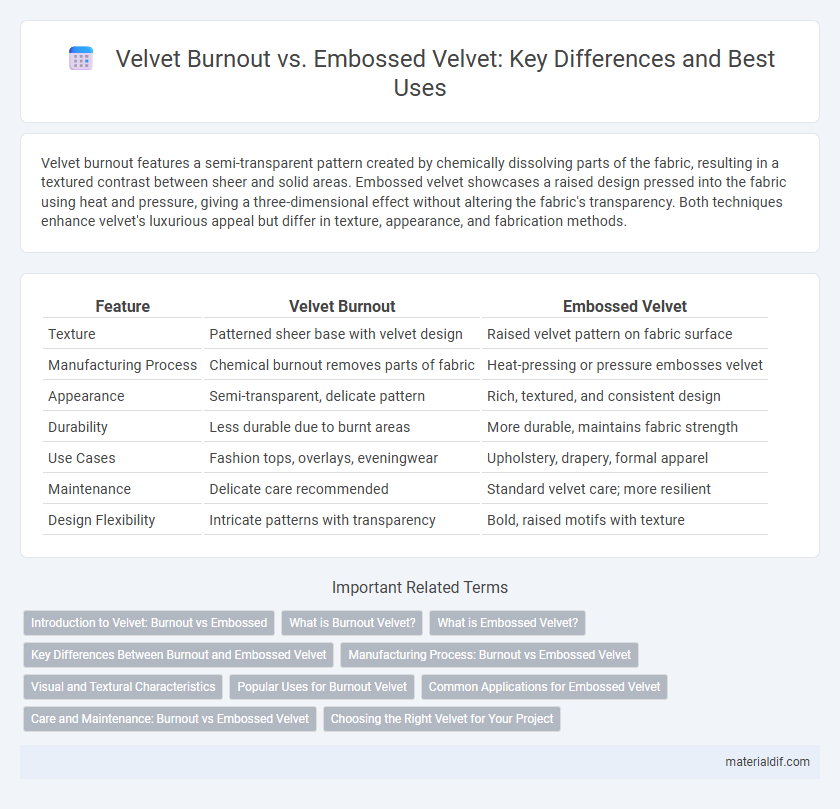Velvet burnout features a semi-transparent pattern created by chemically dissolving parts of the fabric, resulting in a textured contrast between sheer and solid areas. Embossed velvet showcases a raised design pressed into the fabric using heat and pressure, giving a three-dimensional effect without altering the fabric's transparency. Both techniques enhance velvet's luxurious appeal but differ in texture, appearance, and fabrication methods.
Table of Comparison
| Feature | Velvet Burnout | Embossed Velvet |
|---|---|---|
| Texture | Patterned sheer base with velvet design | Raised velvet pattern on fabric surface |
| Manufacturing Process | Chemical burnout removes parts of fabric | Heat-pressing or pressure embosses velvet |
| Appearance | Semi-transparent, delicate pattern | Rich, textured, and consistent design |
| Durability | Less durable due to burnt areas | More durable, maintains fabric strength |
| Use Cases | Fashion tops, overlays, eveningwear | Upholstery, drapery, formal apparel |
| Maintenance | Delicate care recommended | Standard velvet care; more resilient |
| Design Flexibility | Intricate patterns with transparency | Bold, raised motifs with texture |
Introduction to Velvet: Burnout vs Embossed
Velvet burnout features strategically burned-out patterns that create a semi-transparent effect, enhancing texture and visual depth in fabric design. Embossed velvet undergoes a heat-pressing process that imprints raised patterns, providing a tactile, three-dimensional surface with distinct contrast between the plush and flat areas. Both techniques elevate velvet's luxurious appeal, offering unique aesthetic qualities suited for fashion and interior design applications.
What is Burnout Velvet?
Burnout velvet is a unique fabric where a chemical process dissolves parts of the velvet pile, creating a semi-transparent pattern with contrasting textures. This technique combines plush velvet areas with sheer sections, offering a lightweight and breathable material ideal for fashion and home decor. The distinctive look of burnout velvet enhances visual depth and adds a luxurious, tactile appeal compared to traditional embossed velvet.
What is Embossed Velvet?
Embossed velvet features a raised pattern created by heat pressing or embossing techniques, giving it a textured and dimensional surface compared to smooth velvet burnout. This method uses heat and pressure to imprint designs onto the velvet pile, enhancing visual interest and tactile appeal without compromising the fabric's softness. Embossed velvet is often preferred for upholstery and fashion applications where intricate patterns and durability are desired.
Key Differences Between Burnout and Embossed Velvet
Burnout velvet features a semi-transparent pattern created by chemically dissolving parts of the fabric, resulting in a delicate, sheer texture that contrasts with the plush velvet areas. Embossed velvet, on the other hand, is produced through heat-pressing or stamping, which raises or imprints patterns onto the fabric's surface, giving it a three-dimensional, textured feel without altering transparency. The key differences lie in their production methods, texture, and visual effects--burnout velvet offers a see-through design with soft contrasts, while embossed velvet provides a raised, tactile pattern with full fabric opacity.
Manufacturing Process: Burnout vs Embossed Velvet
Burnout velvet is created through a chemical process where a fabric composed of two different fibers undergoes selective dissolution, removing one fiber to produce semi-transparent patterns. Embossed velvet involves pressing patterns onto the fabric using heated rollers or plates, which compress the pile to create raised designs without altering the fiber composition. The manufacturing process of burnout velvet relies on fiber compatibility and chemical resistance, whereas embossed velvet depends on heat, pressure, and mechanical deformation for pattern formation.
Visual and Textural Characteristics
Velvet burnout showcases a unique semi-transparent pattern created by chemically dissolving parts of the fabric, resulting in a delicate blend of sheer and plush textures that emphasize visual contrast. Embossed velvet features raised patterns formed through heat and pressure applications, producing a tactile, dimensional surface with a rich, sculpted appearance. The visual impact of burnout velvet lies in its intricate, lace-like designs, whereas embossed velvet offers a bold, three-dimensional texture that enhances depth and luxury.
Popular Uses for Burnout Velvet
Burnout velvet is widely favored in fashion for its delicate, sheer patterns created by dissolving in fabric, making it ideal for luxurious evening gowns and stylish tops. Its semi-transparent texture offers a lightweight alternative to traditional embossed velvet, often used in curtains and upholstery. The unique combination of opacity and translucence in burnout velvet enhances aesthetic appeal in high-end apparel and home decor.
Common Applications for Embossed Velvet
Embossed velvet is commonly used in upholstery, fashion, and interior decor due to its textured patterns that add visual interest and depth. Unlike plain velvet that can show wear more quickly, embossed velvet maintains its elegance in high-traffic areas, making it suitable for furniture, drapery, and luxury accessories. The raised designs on embossed velvet enhance tactile appeal, frequently chosen for decorative cushions, handbags, and evening wear to provide a sophisticated, durable finish.
Care and Maintenance: Burnout vs Embossed Velvet
Burnout velvet requires gentle hand washing or dry cleaning to preserve its delicate sheer and solid contrasts, avoiding high heat which can damage the fabric's texture. Embossed velvet benefits from low-heat ironing on the reverse side to maintain its raised patterns, with spot cleaning preferred to prevent crushing the embossed design. Both types demand careful storage away from direct sunlight to prevent fading and loss of softness in their unique finishes.
Choosing the Right Velvet for Your Project
Choosing the right velvet for your project depends on understanding the differences between burnout velvet and embossed velvet. Burnout velvet features a semi-transparent, sheer pattern created by chemically burning away fibers, making it ideal for lightweight, decorative applications requiring texture contrast. Embossed velvet, on the other hand, has a raised, three-dimensional pattern pressed into the fabric with heat and pressure, offering a durable, luxurious texture suited for upholstery and heavy-use furnishings.
Velvet burnout vs embossed velvet Infographic

 materialdif.com
materialdif.com